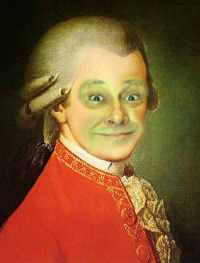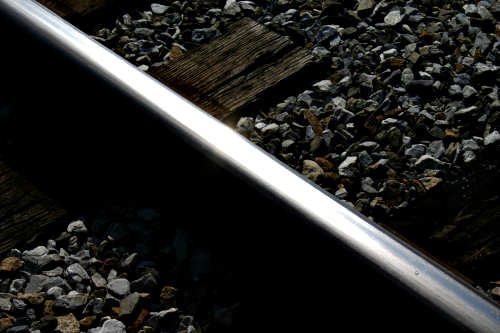A 365-Day Project
"We Are All Mozart"
A project to create
new works and change
the perception of the
music of our time.


 August 20, 2006
August 20, 2006 
In yesterday's commentary, so much was compressed: the past, present and future of nonpop music and the anticipated crumbling of the symphonic stratum. That's the failure in being polemical. It can sound so convincing yet be vastly sparse.
Almost but not quite implicit was the failure of the symphony orchestra -- which is far from the meaning or intent. The assimilation or submersion of the symphonic class will certainly be evidenced by orchestra closures and stopgap repertoire ossification into NPR-style mediocrity on the way, but this stilstaandheid is not new. Effectively the same repertoire, with a few adjustments for rediscovered Mahler and resurgent Mozart and Phantom of the Opera-style film suites, has been on the symphonic program for seventy-five years. Large ensembles survive through conservative entertainment programming; that has become their purpose in a marketing patter of recursive logic and self-fulfilling prophesy.
If that's the case, what makes the symphony orchestra important? Why is it not simply abandoned by composers? "Death of the symphony" and "death of the orchestra" respectively return 4,500 and 12,000 results on a web search. It's been the talk of embittered composers since the raucous split of the 1920s. Like its companion-in-charms the opera, though, the symphony appeals to listeners who have discovered it through recordings and radio. Its power of enchantment arises from the manifestation of those recordings into the real air, and not from its ability to present the imaginary and unheard.
As such, it is a tool quite different from that expected by composers. Indeed, most composers still see the orchestra and the string quartet as the career Everests -- to be conquered no matter what the social cost, quality of work, or detritus left behind. The mind-meld of conservative orchestra and careerist composer is strong, in particular because of the "American Commission," the purchase of music that has both a written and an implicit contract: a composition that does not exceed ten minutes, that can be done in fewer rehearsals than anything else on the program, that is accessible (a code word for non-confrontational, avoiding new compositional approaches, or even strictly tonal), and that doesn't cost more than its advertising to purchase.
With the preponderance of these "American Commissions," why do composers accept these limitations? It is the ineffable sensuousness of the orchestra itself, the nearly infinite permutations of tone and pitch and dynamic and contour. It is the challenge of writing a book of sonnets -- each tightly circumscribed and full of insight -- that together form a novel with the aural complexity of a hall of mirrored meanings, all reflecting our own sonic image as we walk through it. The symphony orchestra becomes ourselves incarnate. Certainly there are thousands of composers who do not see themselves first, yet they still write the notes down for others to play. Even for the most humble composer, it is an arrogance so sweet to watch and hear -- to cause -- twenty-five or fifty or a hundred bodies to bend before one's ideas and fill the air with our sounds.
The orchestra is also organic. Unlike mirrors that reflect, it is a sensuous enfolding of hidden places: the oboe that rises from inaudibility to sweetness, the unexpected snap of the head toward a riot of horns, the angular discourse of double-stopped violins. Each instrument has a library's worth of performance techniques and a history of implicit musical meaning. As the ensemble grows, the possibilities rise geometrically -- and moreso as identical instruments become choirs, similar instruments become sections, and traditional combinations become concerted. Physics of sound come into play: the manner in which the instruments work together, and how the harmonic qualities of instruments nestle into those of others.
And none of this even begins to account for the implications of prior art by other composers. Among the compositional choices made are bound to be ones made in the past, and known to audiences. Beethoven's four notes that launch the fifth symphony, Bach's three that propel the most famous toccata or Mozart's nightly three, Stravinsky's voicing of octophonic rite chords or minor psalmic ones. Implications, intended or not, flood the experienced listeners' ears.
Like architects, symphonic composers must consider the details of plumbing as well as the grand and obvious structures. Is the composition a coherent, moving whole that will sweep away the audience -- and will the second horn have time to clear the spit valve? Does the counterpoint of strings invoke the ghost of the mighty Bach -- and are the page turns in the right place? Will the mystery of low brass and winds breathe in from the sinuous and sultry East -- and are there cross-cues if the contrabass trombone doesn't show up?
With all these problems, why not use virtual orchestras (electronic versions using samples of physical acoustic instruments) as I have often encouraged? The answer lies in what composer Matthew Fields has called the human desire for social congress combined with "splendor in sound." Recently he had his large-orchestra composition Hubble Space Telescope Views read as part of a workshop for composers, and later wrote about how much he had learned from a few minutes with a performing harpist vs. hours of study with books, how he was gratified to hear a real bell tree played in its natural state, and proud that "the soloists took ownership of their solos." Contrast his reaction (and unfortunately, union rules prevent "Dr. Matt" from posting the actual performance recording) with the gut response to the adequately rendered but otherwise sterile virtual orchestra version. (Whether artificial intelligence can improve this musical situation will be known in a few short years, but social congress and sharing of experience will always remain in play.)
The symphony orchestra is malleable, so that every performance in every hall on any given night is in no way the same as another performance. This is the wonder of interpretation that draws performers to music already well known -- and listeners to their concerts. The accusation of "reading into" a book or poem or visual artwork is often leveled at professors and their eager students, but "reading into" a work of art is in fact a code for the valuable discovery of what the artist has included that was derived from having been an artist with a rich body of experience and technique and history. Recently I wrote of the limitations faced by one without sufficiency in the history and technique because there is indeed the complexity of a fine wine (also subject to excessive metaphor) in the weave and orchestration of experienced composers. The frustration of conductors with conflicting manuscripts of the same composition becomes evident. If a point of orchestration has been changed or some measures deleted or expanded, how is the music expressed at the disputed place as well as in the phrases leading into and out of those changes? What differences of performance must be made in other areas of the composition that may have or may now reflect on that material?
It is no simple task to interpret a score, and far less simple to create one. Beyond the technical skills, a composer is taken by the forces available and determined to use every one -- particularly in an era when opportunities for new nonpop at the orchestral level are so few. One thinks of melody and harmony and rhythm and orchestration, but there are also spatial elements to consider. Will the instruments engage in a conversation? In sections? Section to section, choir to choir? One among many, here or there? Will the obvious elements be shrouded by cleverness or magical subtlety? And in this consideration, Tchaikovsky's sixth symphony remains a valuable lesson, with the melody of its final movement never played intact but rather shared in its alternate notes between first and second violins. Perhaps there is a consideration of the mystery of solo lines inside a composition: Should, for example, the continuous solo string chorale in my Softening Cries be soli or, as indicated, an interior string quartet? What is the sonic and experiential difference, for players and audience? What is audible in this among the work's full sweep?
The surface and hidden motivations and challenges and rewards for writing symphonic music are so many as to approach the infinite. By contrast, the barriers to performance are fewer but powerful and historical, to which we return when speaking about the anticipated submersion of the symphonic class.

Symphonic textures in a slice of railroad: delicacy, darkness, shimmer, direction, and an unexpected view.